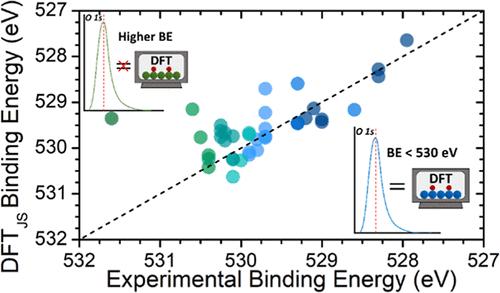预测金属上o1s结合能的DFT精度基准
IF 3.2
3区 化学
Q2 CHEMISTRY, PHYSICAL
引用次数: 0
摘要
x射线光电子能谱(XPS)是探测材料,特别是与太阳能电池和催化相关的金属和金属氧化物的电子结构和组成的有力工具。密度泛函理论(DFT)通常用于支持XPS峰分配,但其预测氧种类的可靠性尚不明确。在这里,我们编制了一个大的实验氧结合能数据集,并评估了相应的DFT预测。我们发现,随着金属键合氧原子结合能的增加,特别是在≈530 eV以上,dft预测值的精度普遍下降。因此,高结合能的原子氧,例如那些被认为对选择性银催化环氧化有活性的原子氧,较少被代表。氧的化学性质也影响准确性,在整个能量范围内更可靠地捕获分子结合的氧。这些发现说明了DFT解释XPS光谱的局限性,并为改进计算方法提供了基准。本文章由计算机程序翻译,如有差异,请以英文原文为准。

Benchmarking DFT Accuracy in Predicting O 1s Binding Energies on Metals
X-ray photoelectron spectroscopy (XPS) is a powerful tool for probing the electronic structure and composition of materials, particularly metals and metal oxides of relevance to solar cells and catalysis. Density functional theory (DFT) is often used to support XPS peak assignments, but its reliability for predicting oxygen species is not well established. Here, we compile a large data set of experimental oxygen binding energies and evaluate corresponding DFT predictions. We find that as the binding energies of metal-bound atomic oxygen species increase, especially above ≈530 eV, there is a general decrease in the accuracy of DFT-predicted values. Thus, high-binding-energy atomic oxygen species, such as those proposed as active for selective Ag-catalyzed epoxidation, are less well represented. The chemical nature of the oxygen species also influences accuracy, with molecularly bound species more reliably captured across the entire range of energies. These findings illustrate the limitations of DFT for interpreting XPS spectra and provide a benchmark for improving computational methods.
求助全文
通过发布文献求助,成功后即可免费获取论文全文。
去求助
来源期刊

The Journal of Physical Chemistry C
化学-材料科学:综合
CiteScore
6.50
自引率
8.10%
发文量
2047
审稿时长
1.8 months
期刊介绍:
The Journal of Physical Chemistry A/B/C is devoted to reporting new and original experimental and theoretical basic research of interest to physical chemists, biophysical chemists, and chemical physicists.
 求助内容:
求助内容: 应助结果提醒方式:
应助结果提醒方式:


